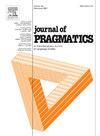Locating summonses
IF 1.8
1区 文学
0 LANGUAGE & LINGUISTICS
引用次数: 0
Abstract
Summonses are a crucial resource for prospective participants attempting to establish contact in the opening phase of an interaction. In conversation analysis, they have been studied predominantly as the first pair part of the summons-answer sequence, functioning as “attention-getting devices.” We show that summonses can also be instrumental for achieving a more fundamental task: locating a prospective coparticipant in space. Indeed, coparticipants may rely on summons-answer sequences in order to look for their future interlocutors and identify where they are. Our study focuses on stand-alone first-name summonses in the opening phase of interactions involving a recruiting activity and considers locating the prospective coparticipant and recruitee as a preliminary to it. This article contributes to the understanding of summonses and recruitment in face-to-face “on the move” interactions. The data are video recordings of staff corridor interactions in a hospital outpatient clinic in the French-speaking part of Switzerland.
定位传票
传票对于在互动的开始阶段试图建立联系的潜在参与者来说是一个至关重要的资源。在对话分析中,它们主要被研究为召唤-回答序列的第一对部分,起着“吸引注意力的装置”的作用。我们表明,召唤也可以帮助实现一个更基本的任务:在空间中定位一个潜在的合作者。事实上,共同参与者可能依靠传唤-回答序列来寻找他们未来的对话者并确定他们在哪里。我们的研究重点是在招聘活动互动的开始阶段单独的名字召唤,并认为定位潜在的合作参与者和被招聘者是它的初步工作。本文有助于理解面对面的“移动”互动中的召唤和招募。这些数据是瑞士法语区一家医院门诊部工作人员走廊互动的录像。
本文章由计算机程序翻译,如有差异,请以英文原文为准。
求助全文
约1分钟内获得全文
求助全文
来源期刊

Journal of Pragmatics
Multiple-
CiteScore
3.90
自引率
18.80%
发文量
219
期刊介绍:
Since 1977, the Journal of Pragmatics has provided a forum for bringing together a wide range of research in pragmatics, including cognitive pragmatics, corpus pragmatics, experimental pragmatics, historical pragmatics, interpersonal pragmatics, multimodal pragmatics, sociopragmatics, theoretical pragmatics and related fields. Our aim is to publish innovative pragmatic scholarship from all perspectives, which contributes to theories of how speakers produce and interpret language in different contexts drawing on attested data from a wide range of languages/cultures in different parts of the world. The Journal of Pragmatics also encourages work that uses attested language data to explore the relationship between pragmatics and neighbouring research areas such as semantics, discourse analysis, conversation analysis and ethnomethodology, interactional linguistics, sociolinguistics, linguistic anthropology, media studies, psychology, sociology, and the philosophy of language. Alongside full-length articles, discussion notes and book reviews, the journal welcomes proposals for high quality special issues in all areas of pragmatics which make a significant contribution to a topical or developing area at the cutting-edge of research.
 求助内容:
求助内容: 应助结果提醒方式:
应助结果提醒方式:


